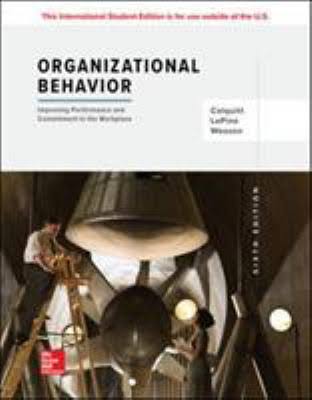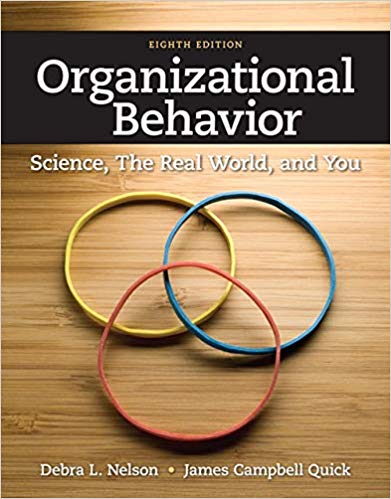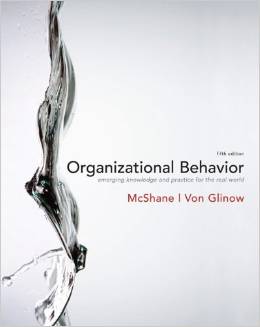Organizational Behavior Improving Performance and Commitment in the Workplace 6Th edition By Colquitt – Test Bank
Organizational Behavior, 6e (Colquitt)
Chapter 3 Organizational Commitment
1) Organizational commitment is the desire on the part of an employee to remain a member of the organization.
Answer: TRUE
Explanation: Organizational commitment is defined as the desire on the part of an employee to remain a member of the organization. Organizational commitment influences whether an employee stays a member of the organization (is retained) or leaves to pursue another job (turns over).
Difficulty: 1 Easy
Topic: Organizational commitment
Learning Objective: 03-01 What is organizational commitment? What is withdrawal behavior? How are the two connected?
Bloom’s: Remember
AACSB: Knowledge Application
Accessibility: Keyboard Navigation
2) Affective commitment is defined as a desire to remain a member of an organization due to an emotional attachment to, and involvement with, that organization.
Answer: TRUE
Explanation: Affective commitment is defined as a desire to remain a member of an organization due to an emotional attachment to, and involvement with, that organization.
Difficulty: 1 Easy
Topic: Affective commitment
Learning Objective: 03-02 What are the three types of organizational commitment, and how do they differ?
Bloom’s: Remember
AACSB: Knowledge Application
Accessibility: Keyboard Navigation
3) Employees who feel a sense of continuance commitment identify with the organization, accept the organization’s goals and values, and are more willing to exert extra effort on behalf of the organization.
Answer: FALSE
Explanation: Employees who feel a sense of affective commitment identify with the organization, accept the organization’s goals and values, and are more willing to exert extra effort on behalf of the organization. Continuance commitment is defined as a desire to remain a member of an organization because of awareness of the costs associated with leaving it.
Difficulty: 2 Medium
Topic: Organizational commitment
Learning Objective: 03-02 What are the three types of organizational commitment, and how do they differ?
Bloom’s: Understand
AACSB: Knowledge Application
Accessibility: Keyboard Navigation
4) The social influence model of withdrawal behavior suggests that employees with fewer bonds will be most likely to quit the organization.
Answer: FALSE
Explanation: The social influence model suggests that employees who have direct linkages with “leavers” will themselves become more likely to leave.
Difficulty: 1 Easy
Topic: Withdrawal behavior
Learning Objective: 03-02 What are the three types of organizational commitment, and how do they differ?
Bloom’s: Remember
AACSB: Knowledge Application
Accessibility: Keyboard Navigation
5) Continuance commitment tends to create more of a passive form of loyalty than affective commitment.
Answer: TRUE
Explanation: Continuance commitment tends to create more of a passive form of loyalty.
Difficulty: 1 Easy
Topic: Organizational commitment
Learning Objective: 03-02 What are the three types of organizational commitment, and how do they differ?
Bloom’s: Remember
AACSB: Knowledge Application
Accessibility: Keyboard Navigation
6) Embeddedness summarizes employees’ links to their organization and community, their sense of fit with that organization and community, and what they would have to sacrifice for a job change.
Answer: TRUE
Explanation: Embeddedness consists of the work and nonwork forces that can bind us to our current employer. It summarizes employees’ links to their organization and community, their sense of fit with their organization and community, and what they would have to sacrifice for a job change.
Difficulty: 1 Easy
Topic: Organizational commitment
Learning Objective: 03-02 What are the three types of organizational commitment, and how do they differ?
Bloom’s: Remember
AACSB: Knowledge Application
Accessibility: Keyboard Navigation
7) Affective commitment exists when there is a sense that staying is the “right” or “moral” thing to do.
Answer: FALSE
Explanation: Normative commitment exists when there is a sense that staying is the “right” or “moral” thing to do.
Difficulty: 1 Easy
Topic: Affective commitment
Learning Objective: 03-02 What are the three types of organizational commitment, and how do they differ?
Bloom’s: Remember
AACSB: Knowledge Application
Accessibility: Keyboard Navigation
8) Loyalty is defined as an active, constructive response to a negative work event in which individuals attempt to improve the situation.
Answer: FALSE
Explanation: Loyalty is defined as a passive, constructive response that maintains public support for the situation while the individual privately hopes for improvement.
Difficulty: 1 Easy
Topic: Organizational commitment
Learning Objective: 03-03 What are the four primary responses to negative events at work?
Bloom’s: Remember
AACSB: Knowledge Application
Accessibility: Keyboard Navigation
9) Employees falling under the category of “lone wolves” tend to respond to negative events with voice because they have the desire to improve the status quo and the credibility needed to inspire change.
Answer: FALSE
Explanation: Employees falling under the category of “stars” tend to respond to negative events with voice because they have the desire to improve the status quo and the credibility needed to inspire change.
Difficulty: 2 Medium
Topic: Organizational commitment
Learning Objective: 03-03 What are the four primary responses to negative events at work?
Bloom’s: Remember
AACSB: Knowledge Application
Accessibility: Keyboard Navigation













Reviews
There are no reviews yet.